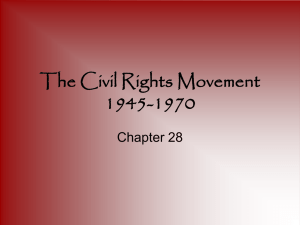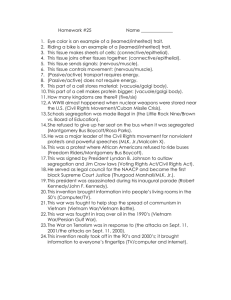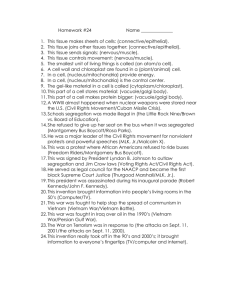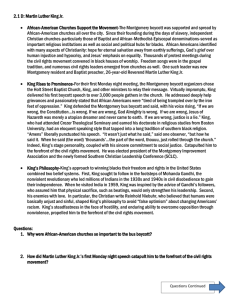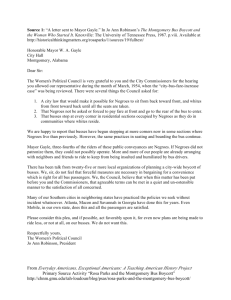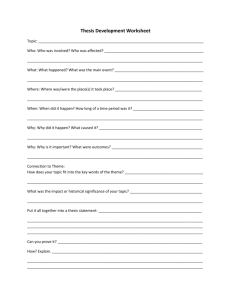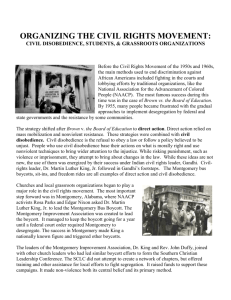Montgomery Bus Boycott Lesson Plan
advertisement
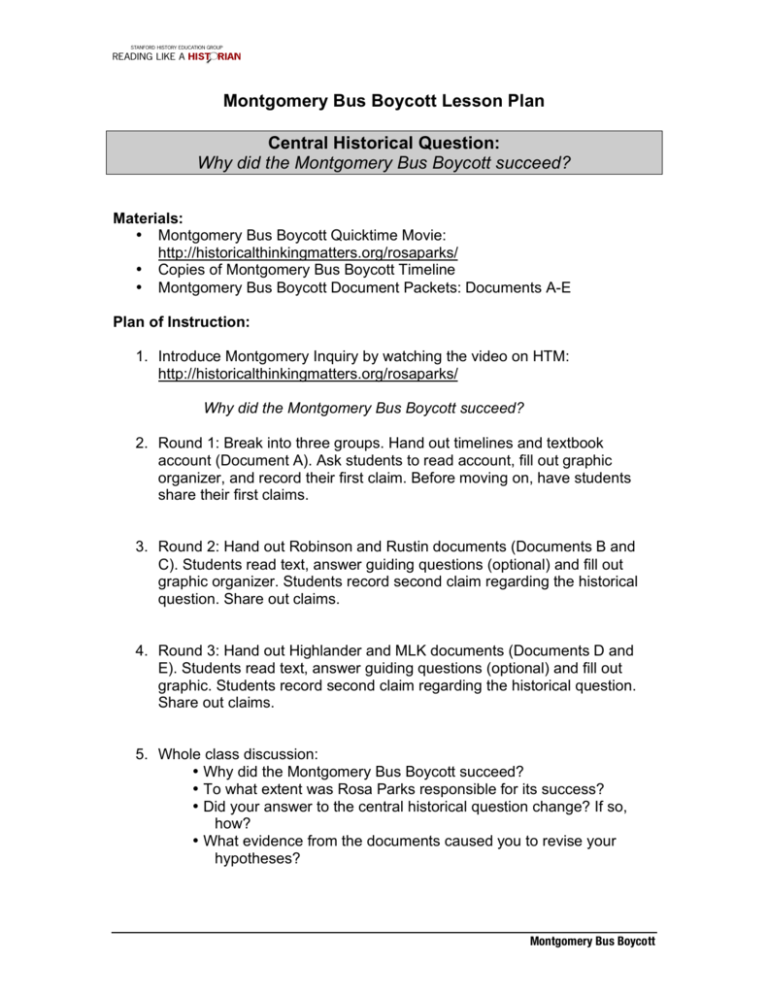
Montgomery Bus Boycott Lesson Plan Central Historical Question: Why did the Montgomery Bus Boycott succeed? Materials: • Montgomery Bus Boycott Quicktime Movie: http://historicalthinkingmatters.org/rosaparks/ • Copies of Montgomery Bus Boycott Timeline • Montgomery Bus Boycott Document Packets: Documents A-E Plan of Instruction: 1. Introduce Montgomery Inquiry by watching the video on HTM: http://historicalthinkingmatters.org/rosaparks/ Why did the Montgomery Bus Boycott succeed? 2. Round 1: Break into three groups. Hand out timelines and textbook account (Document A). Ask students to read account, fill out graphic organizer, and record their first claim. Before moving on, have students share their first claims. 3. Round 2: Hand out Robinson and Rustin documents (Documents B and C). Students read text, answer guiding questions (optional) and fill out graphic organizer. Students record second claim regarding the historical question. Share out claims. 4. Round 3: Hand out Highlander and MLK documents (Documents D and E). Students read text, answer guiding questions (optional) and fill out graphic. Students record second claim regarding the historical question. Share out claims. 5. Whole class discussion: • Why did the Montgomery Bus Boycott succeed? • To what extent was Rosa Parks responsible for its success? • Did your answer to the central historical question change? If so, how? • What evidence from the documents caused you to revise your hypotheses? Montgomery Bus Boycott Citations: Buggey J., Danzer, G., Mitsakos, C., & Risinger C. (1984) America! America! (Glenview, IL: Scott, Foresman & Co.) p. 653. "A letter sent to Mayor Gayle," in Jo Ann Robinson’s The Montgomery Bus Boycott and the Women Who Started It, (Knoxville: The University of Tennessee Press, 1987), viii. http://historicalthinkingmatters.org/rosaparks/0/inquiry/main/resources/19/ Bayard Rustin, "Montgomery Diary," in Daybreak of Freedom: The Montgomery Bus Boycott, Stewart Burns, ed. (Chapel Hill, NC: The University of North Carolina Press, 1997), 164-170. http://historicalthinkingmatters.org/rosaparks/0/inquiry/main/resources/25/ Martin Luther King speech at the March 22 MIA meeting, as reported by Anna Holden, in Daybreak of Freedom: The Montgomery Bus Boycott, Stewart Burns, ed. (Chapel Hill, NC: The University of North Carolina Press, 1997), 212-219. [Burns found Holden’s report in the Preston Valien Collection, Amistad Research Center, Tulane University, New Orleans.] http://historicalthinkingmatters.org/rosaparks/0/inquiry/main/resources/24/ © Copyright 2009, Avishag Reisman and Bradley Fogo. Montgomery Bus Boycott Montgomery Bus Boycott Timeline Jan. 1863 Emancipation Proclamation July 1868 Fourteenth Amendment May 1896 Plessy v. Fergusen; 'Separate but Equal' ruled constitutional. May 1909 Niagara Movement convenes (later becomes NAACP), pledging to promote racial equality. 1941 - 1945 U.S. involvement in WWII. 1949 Women’s Political Council in Montgomery, Alabama created. June 1950 July 1953 U.S. involvement in the Korean War. June 1953 African-Americans in Baton-Rouge, Louisiana boycott segregated city buses. May 1954 Brown v. Board of Education of Topeka, Kansas Aug. 1955 Murder of Emmett Till. Dec. 1, 1955 Rosa Parks refuses to give up her seat and is arrested. Dec. 5, 1955 Montgomery Improvement Council formed, Martin Luther King, Jr. named President. Nov. 1956 Supreme Court affirms decision in Browder v. Gayle which found bus segregation unconstitutional. Dec. 1956 Supreme Court rejects city and state appeals on its decision. Buses are desegregated in Montgomery. Montgomery Bus Boycott Document A: Textbook The Montgomery Bus Boycott In 1955, just after the school desegregation decision, a black woman helped change American history. Like most southern cities (and many northern ones), Montgomery had a law that blacks had to sit in the back rows of the bus. One day, Rosa Parks boarded a city bus and sat down in the closest seat. It was one of the first rows of the section where blacks were not supposed to sit. The bus filled up and some white people were standing. The bus driver told Rosa Parks that she would have to give up her seat to a white person. She refused and was arrested. The next evening, black leaders, many of them church ministers, met to decide if they should protest. A young minister who just moved to Montgomery from Atlanta, Martin Luther King Jr., soon became the leader of the group. King and the others called for a black boycott of the Montgomery bus system. The boycott meant blacks refused to ride the buses. For months, the buses were almost empty because most of the riders had been black. Then, the boycott spread to white businesses in downtown Montgomery. King was arrested and jailed, but he continued to urge his followers to use a path of “non-violent resistance.” This meant that they would break laws that discriminated against blacks, but that they would not use violence… By 1960, black Americans had made some progress toward equality. The Supreme Court and other government actions had opened the door. But most blacks still were forced to live a second-class type of life. Source: Buggey J., Danzer, G., Mitsakos, C., & Risinger C. (1984). America! America! (Glenview, IL: Scott, Foresman & Co.), p. 653. Montgomery Bus Boycott Document B: Letter from Robinson to the Mayor Jo Ann Robinson was the president of the Women’s Political Council, an organization of African American professional women in Montgomery, founded in 1949. Dear Sir: The Women’s Political Council is very grateful to you and the City Commissioners for hearing out our representative. . . There were several things the Council asked for: 1. A city law that would make it possible for Negroes to sit from back toward front, and whites from front toward back until all the seats are taken. 2. That Negroes not be asked or forced to pay fare at front and go to the rear of the bus to enter. 3. That busses stop at every corner in residential sections occupied by Negroes as they do in communities where whites reside. We are happy to report that busses have begun stopping at more corners now in some sections where Negroes live than previously. However, the same practices in seating and boarding the bus continue. Mayor Gayle, three-fourths of the riders of these public conveyances are Negroes. If Negroes did not patronize them, they could not possibly operate. More and more of our people are already arranging with neighbors and friends to ride to keep from being insulted and humiliated by bus drivers. There has been talk . . . of planning a city-wide boycott of busses. We, sir, do not feel that forceful measures are necessary in bargaining for a convenience which is right for all bus passengers. . . . Respectfully yours, The Women’s Political Council Jo Ann Robinson, President Source: Excerpt from a letter written by Jo Ann Robinson, May 21, 1954. Montgomery Bus Boycott Document C: Bayard Rustin’s Diary Bayard Rustin, an African American civil rights activist, traveled to Montgomery to advise Dr. King and support the bus boycott. Though he was eventually asked to leave Montgomery because leaders feared his reputation as a gay Communist would hurt the movement, he kept a diary of what he found. February 24 42,000 Negroes have not ridden the busses since December 5. On December 6, the police began to harass, intimidate, and arrest Negro taxi drivers who were helping get these people to work. It thus became necessary for the Negro leaders to find an alternative—the car pool. This morning Rufus Lewis, director of the pool…explained that there are three methods in addition to the car pool, for moving the Negro population: 1. Hitch-hiking. 2. The transportation of servants by white housewives. 3. Walking. Later he introduced me to two men, one of whom has walked 7 miles and the other 14 miles, every day since December 5. “The success of the car pool is at the heart of the movement,” Lewis said at the meeting. “It must not be stopped.” I wondered what the response of the drivers would be, since 28 of them had just been arrested on charges of conspiring to destroy the bus company. One by one, they pledged that, if necessary, they would be arrested again and again. Source: Excerpt from Bayard Rustin’s Montgomery Diary, February 24, 1956. Montgomery, Alabama. Montgomery Bus Boycott Document D: Highlander School Virginia Foster Durr was a white woman who supported civil rights for African Americans in Montgomery. Here, Durr writes the director of the Highlander Folk School and his wife. Highlander was a center for training civil rights activists and labor organizers. January 30, 1956 Dear Myles and Zilphia: I just received a newsletter from Highlander giving a summary of the past year’s activities. I think you should add how much you had to do with the Montgomery Bus Boycott which is really making history. LIFE, TIME, CBS, NBC, and countless other papers have been down here covering it. I think it is the first time that a whole Negro community has ever stuck together this way and for so long and I think they are going to win it. But how your part comes in is through the effect the school had on Mrs. Rosa Parks. When she came back she was so happy and felt so liberated. She said the discrimination got worse and worse to bear AFTER having, for the first time in her life, been free of it at Highlander. I am sure that had a lot to do with her daring to risk arrest as she is naturally a very quiet person although she has a strong sense of pride and is, in my opinion, a really noble woman. But you and Zilphia should take pride in what you did for her and what she is doing. Lots of love to all, come and see for yourself. VA Source: Excerpt from a letter written by Virginia Foster Durr to Myles and Zilphia Horton, January 30, 1956. Montgomery, Alabama. Montgomery Bus Boycott Document E: MLK At this Montgomery Improvement Association (MIA) weekly meeting, King speaks to the crowd. Democracy gives us this right to protest and that is all we are doing. We can say honestly that we have not advocated violence, have not practiced it, and have gone courageously on with a Christian movement. Ours is a spiritual movement depending on moral and spiritual fortitude. The protest is still going on. (Great deal of applause here) Freedom doesn’t come on a silver platter. With every great movement toward freedom there will inevitably be trials. Somebody will have to have the courage to sacrifice. You don’t get to the Promised Land without going through the Wilderness. You don’t get there without crossing over hills and mountains, but if you keep on keeping on, you can’t help but reach it. We won’t all see it, but it’s coming and it’s because God is for it. We won’t back down. We are going on with our movement. Let us continue with the same spirit, with the same orderliness, with the same discipline, with the same Christian approach. I believe that God is using Montgomery as his proving ground. God be praised for you, for your loyalty, for your determination. God bless you and keep you, and may God be with us as we go on. Source: Excerpts from a speech by Martin Luther King, Jr., as reported by Anna Holden, a teacher at Fisk University. March 22, 1956. Montgomery, Alabama. Montgomery Bus Boycott Why did the Montgomery Bus Boycott succeed? Guiding Questions Document B: Letter from Robinson to Mayor 1. (sourcing) How long before Rosa Parks’ arrest was this letter written? 2. (sourcing) What was Robinson’s purpose for writing to the mayor? 3. (contextualization) Identify one example of segregation that Robinson and the WPC opposed. 4. (sourcing) Why do you think Robinson reminds the mayor that three-fourths of the bus riders in Montgomery are African American? What is her intention? 5. (corroboration) How does this document either support or expand the textbook version of the Montgomery Bus Boycott? Document C: Bayard Rustin’s Diary 1. (sourcing) How long after the bus boycott began was this document written? 2. (contextualization) How was it possible for African Americans to stay off the buses, but still get to work during the boycott? 3. (contextualization) Who does this document suggest were important to the success of the boycott? Montgomery Bus Boycott Document D: Highlander School 1. (sourcing) What is the author’s skin color? Why might that be important? 2. (sourcing) When was this written? How long had the boycott been going on? 3. (contextualization) According to Durr, what did Myles and Zilphia Horton have to do with the Montgomery Bus Boycott? 4. (contextualization) According to this document, is the boycott succeeding? What evidence is there in the text to support your answer? 5. (corroboration) Most textbooks refer to Rosa Parks as a tired seamstress. What image of Rosa Parks does this letter convey? Document E: MLK 1. (sourcing) Who was King’s audience? What does that imply about King’s intentions in this speech? 2. (contextualization) What does this document suggest are key factors in the success of the boycott? 3. (close reading and contextualization) Find and list four references to religion in this speech. How does King use religion in this speech? What does this suggest about the role of religion in the boycott? Montgomery Bus Boycott Why was the Montgomery Bus Boycott Successful? Round 1 Document Reasons suggested by this document Evidence from document to support these reasons Textbook Claim A: Why was the Montgomery Bus Boycott Successful? Round 2 Document Reasons suggested by this document Evidence from document to support these reasons Robinson Letter Rustin’s Diary Claim B: Why was the Montgomery Bus Boycott Successful? Montgomery Bus Boycott Why was the Montgomery Bus Boycott Successful? Round 3 Document Reasons suggested by this document Evidence from document to support these reasons Highlander School MLK Speech Final Claim : Why was the Montgomery Bus Boycott Successful? Montgomery Bus Boycott

